power steering CADILLAC SEVILLE 1995 4.G Owners Manual
[x] Cancel search | Manufacturer: CADILLAC, Model Year: 1995, Model line: SEVILLE, Model: CADILLAC SEVILLE 1995 4.GPages: 410, PDF Size: 19.98 MB
Page 109 of 410
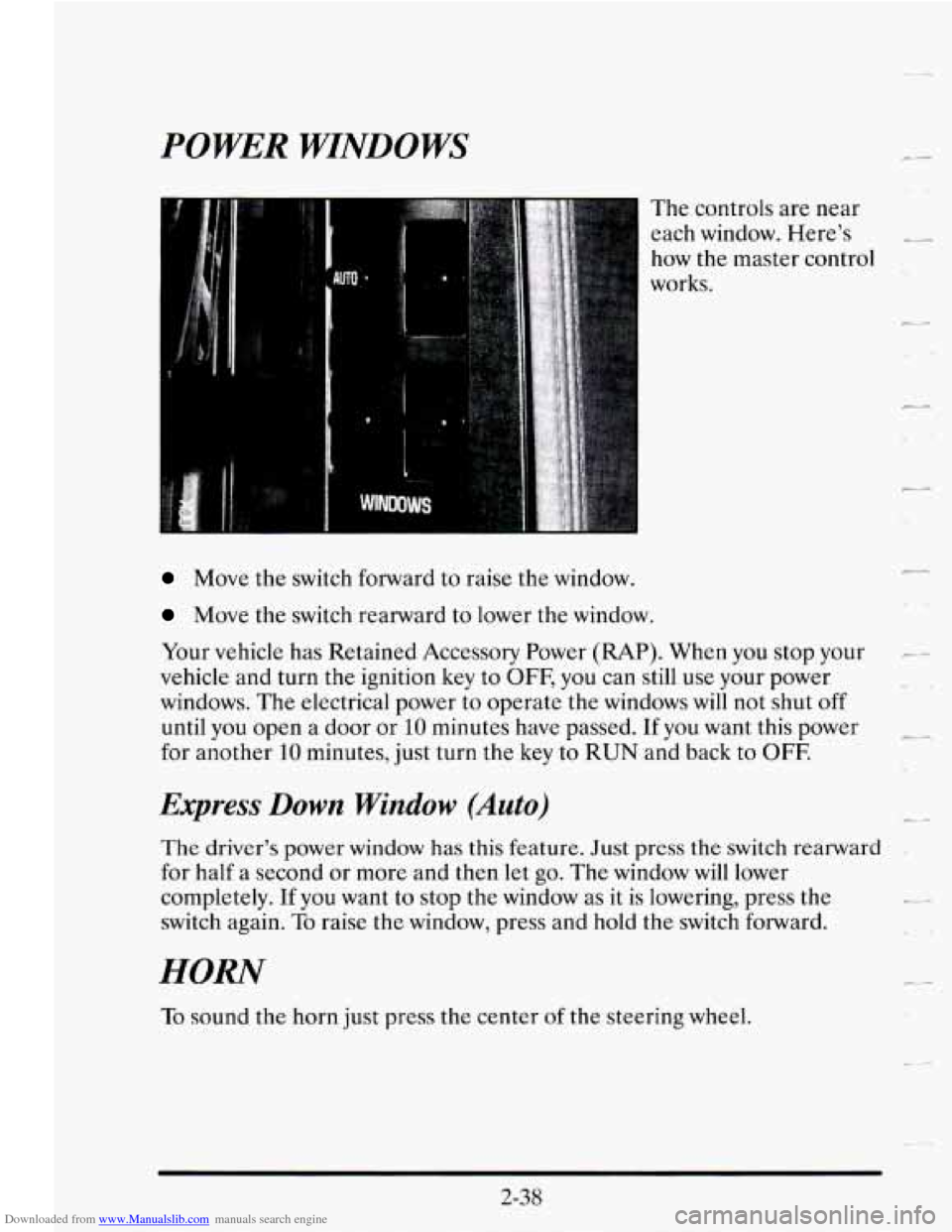
Downloaded from www.Manualslib.com manuals search engine POWER WINDOWS
The controls are near
each window. Here’s
_I
how the master control
works.
Move the switch forward to raise the window.
Move the switch rearward to lower the window.
Your vehicle has Retained Accessory Power
(RAP). When you stop your --
vehicle and turn the ignition key to OFF, you can still use your power
windows.
The electrical power to operate the windows will not shut off
until you open a door or 10 minutes have passed. If you want this power
for another
10 minutes, just turn the key to RUN and back to OFF.
Express Down Window (Auto)
The driver’s power window has this feature. Just press the switch rearward
for half a second or more and then let
go. The window will lower
completely.
If you want to stop the window as it is lowering, press the
switch again.
To raise the window, press and hold the switch forward.
HORN
To sound the horn just press the center of the steering wheel.
2-38
Page 202 of 410
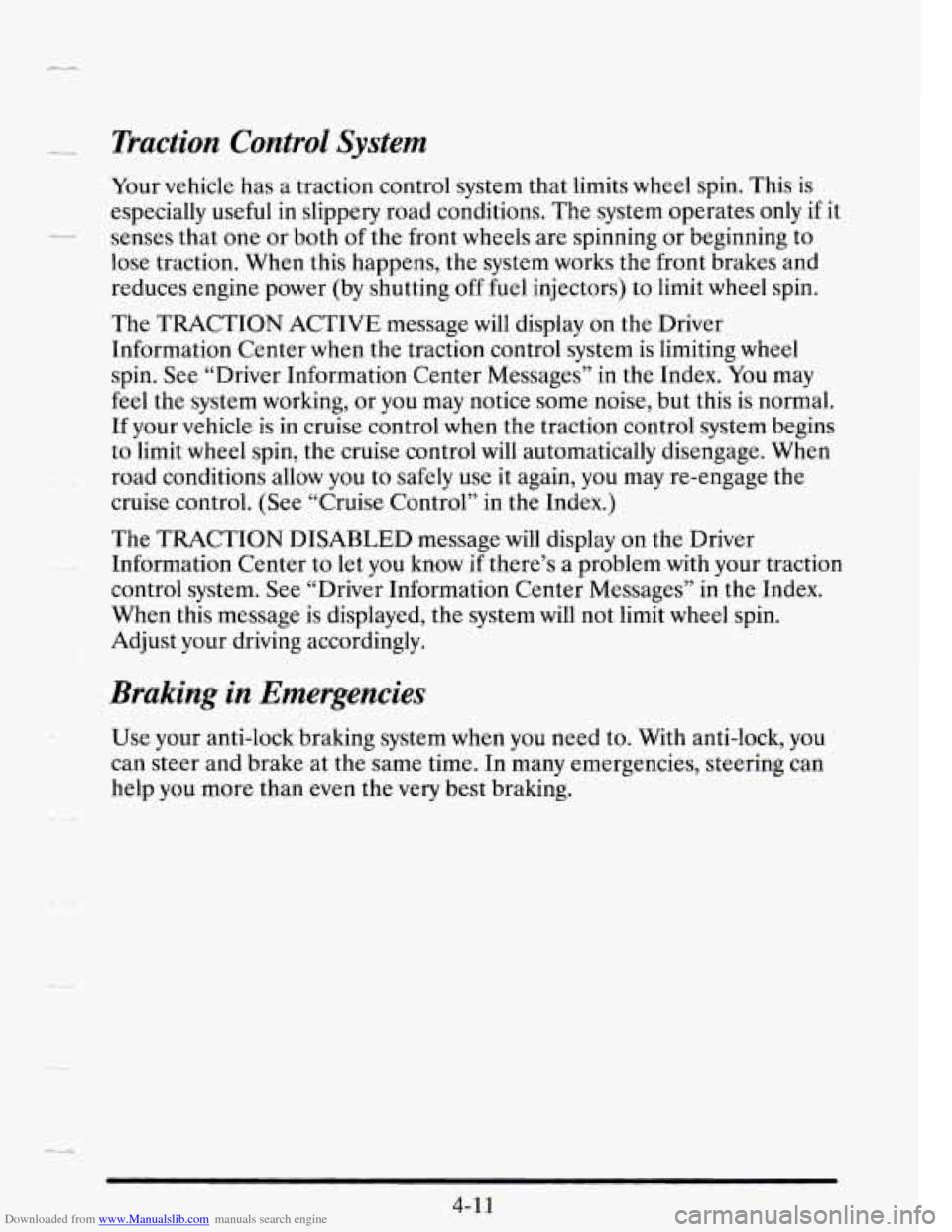
Downloaded from www.Manualslib.com manuals search engine --
Traction Control System
Your vehicle has a traction control system that limits wheel spin. This is
especially useful in slippery road conditions. The system operates only if it
senses that one
or both of the front wheels are spinning or beginning to
lose traction. When this happens, the system works the front brakes and
reduces engine power (by shutting
off fuel injectors) to limit wheel spin.
The TRACTION ACTIVE message will display on the Drivef
Information Center when the traction control system is limiting wheel
spin. See “Driver Information Center Messages” in the Index. You may
feel the system working,
or you may notice some noise, but this is normal.
If your vehicle
is in cruise control when the traction control system begins
to limit wheel spin, the cruise control
will automatically disengage. When
road conditions allow you to safely use it again, you may re-engage the
cruise control. (See “Cruise Control” in the Index.)
The TRACTION DISABLED message will display on the Driver
Information Center to let you know if there’s a problem with your traction
control system. See “Driver Information Center Messages” in the Index.
When this message is displayed, the system will not limit wheel spin.
Adjust your driving accordingly.
Braking in Emergencies
Use your anti-lock braking system when you need to. With anti-lock, you
can steer and brake at the same time. In many emergencies, steering can
help you more than even the very best braking.
4-1 1
Page 203 of 410
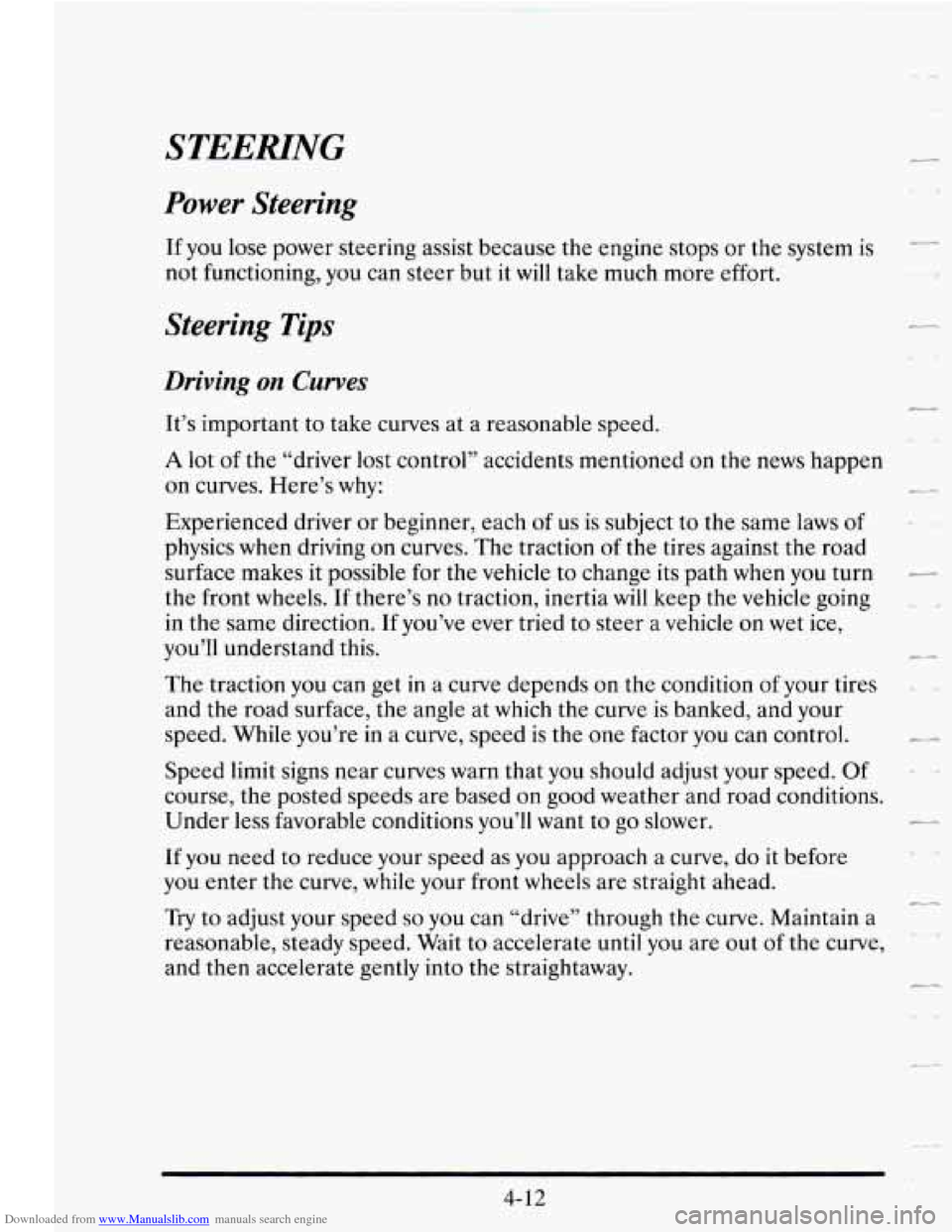
Downloaded from www.Manualslib.com manuals search engine STEERING
Power Steering
If you lose power steering assist because the engine stops or the system is
not functioning, you can steer but it
will take much more effort.
Steering Tips
Driving on Curves
It’s important to take curves at a reasonable speed.
A lot of the “driver lost control” accidents mentioned on the news happen
on curves. Here’s
why:
Experienced driver or beginner, each of us is subject to the same laws of
physics when driving on curves. The traction of the tires against the road
surface makes it possible for the vehicle to change its path when you turn
the front wheels.
If there’s no traction, inertia will keep the vehicle going
in the same direction. If you’ve ever tried to steer a vehicle
on wet ice,
you’ll understand this.
The traction you can get in a curve depends on the condition
of your tires
and the road surface, the angle at which the curve is banked, and your
speed. While you’re
in a curve, speed is the one factor you can control.
Speed limit signs near curves warn that you should adjust your speed.
Of
course, the posted speeds are based on good weather and road conditions.
Under less favorable conditions you’ll want to go slower.
If you need to reduce your speed as you approach a curve, do it before
you enter the curve, while your front wheels are straight ahead.
Try to adjust your speed so you can “drive’’ through the curve. Maintain a
reasonable, steady speed. Wait to accelerate until you are out
of the curve,
and then accelerate gently into the straightaway.
4-12
Page 280 of 410
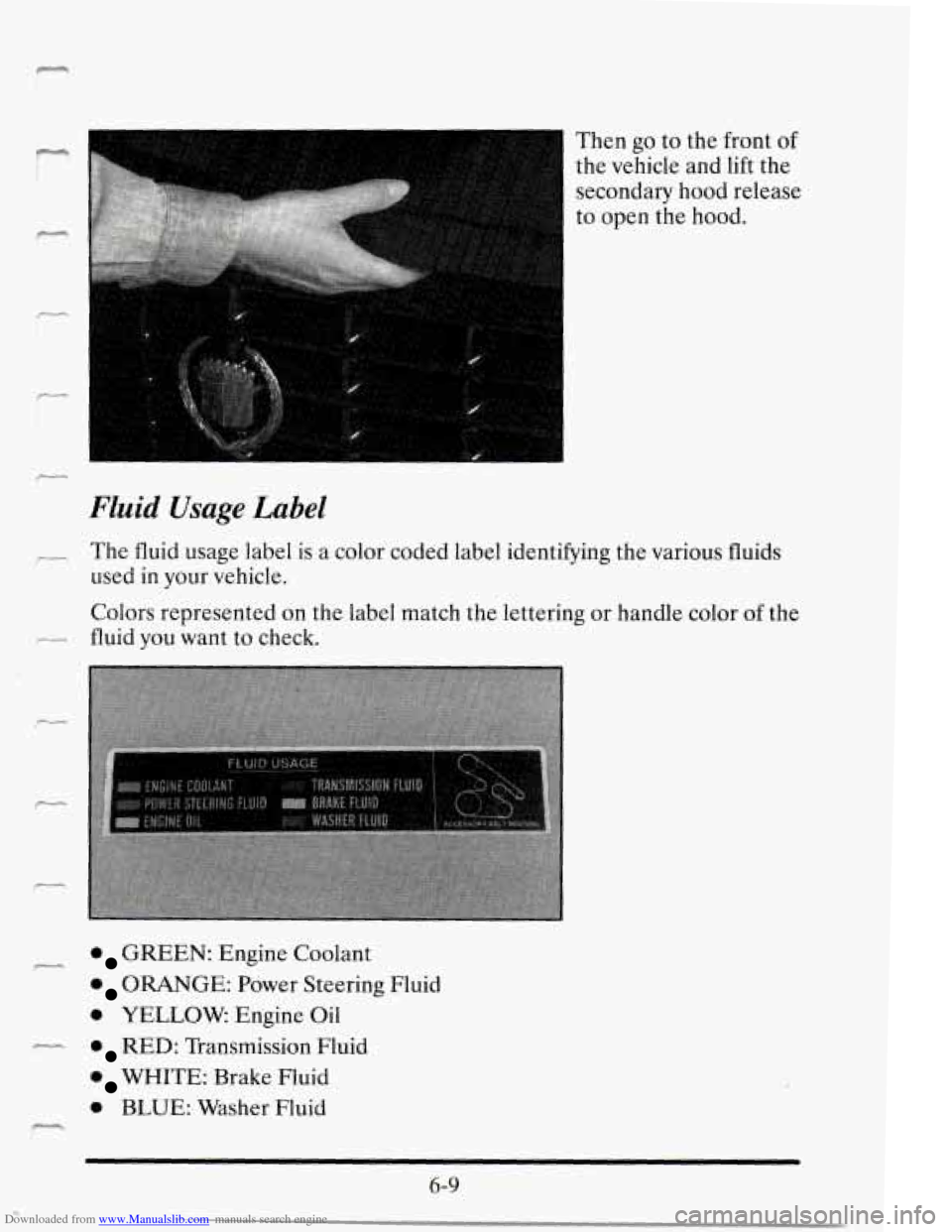
Downloaded from www.Manualslib.com manuals search engine c
Then go to the front of
the vehicle and lift the
secondary hood release
to open the hood.
Fluid Usage Label
The fluid usage label is a color coded label identifying the various fluids
used in your vehicle.
Colors represented on the label match the lettering or handle color of the
fluid you want to check.
GREEN: Engine Coolant
ORANGE: Power Steering Fluid
0 YELLOW. Engine Oil
RED: Transmission Fluid
WHITE: Brake Fluid
0 BLUE: Washer Fluid
P--+
6-9
Page 297 of 410
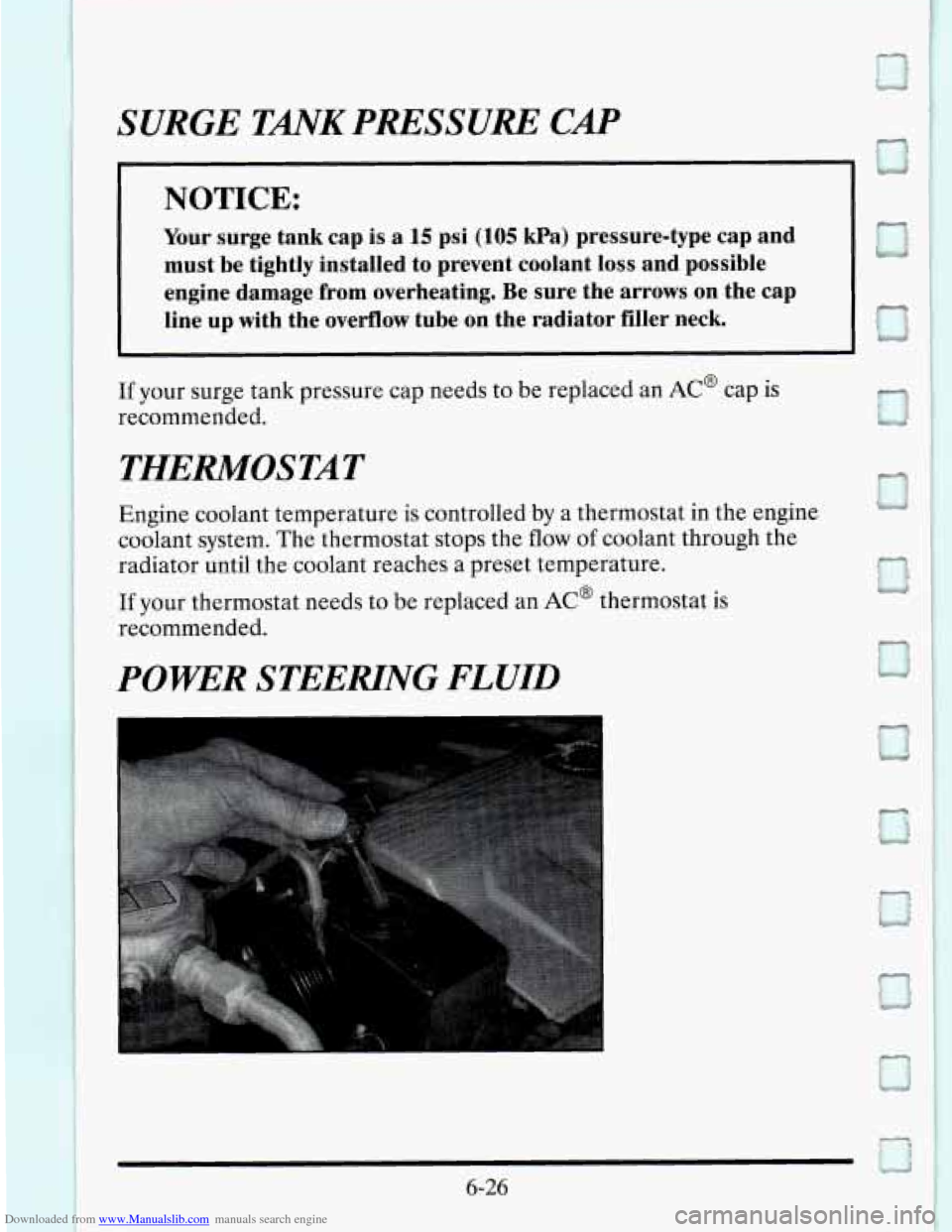
Downloaded from www.Manualslib.com manuals search engine SURGE TANK PRESSURE CAP
NOTICE:
Your surge tank cap is a 15 psi (105 Wa) pressure-type cap and
must be tightly installed to prevent coolant loss and possible
engine damage from overheating. Be sure the arrows on the cap
line up with the overflow tube on the radiator filler neck.
If your surge tank pressure cap needs to be replaced an AC' cap is
recommended.
THERMOSTAT
Engine coolant temperature is controlled by a thermostat in the engine
coolant system. The thermostat stops the
flow of coolant through the
radiator until the coolant reaches a preset temperature.
If your thermostat needs to be replaced an AC@ thermostat is
recommended.
POWER STEERING FLUID
Page 298 of 410
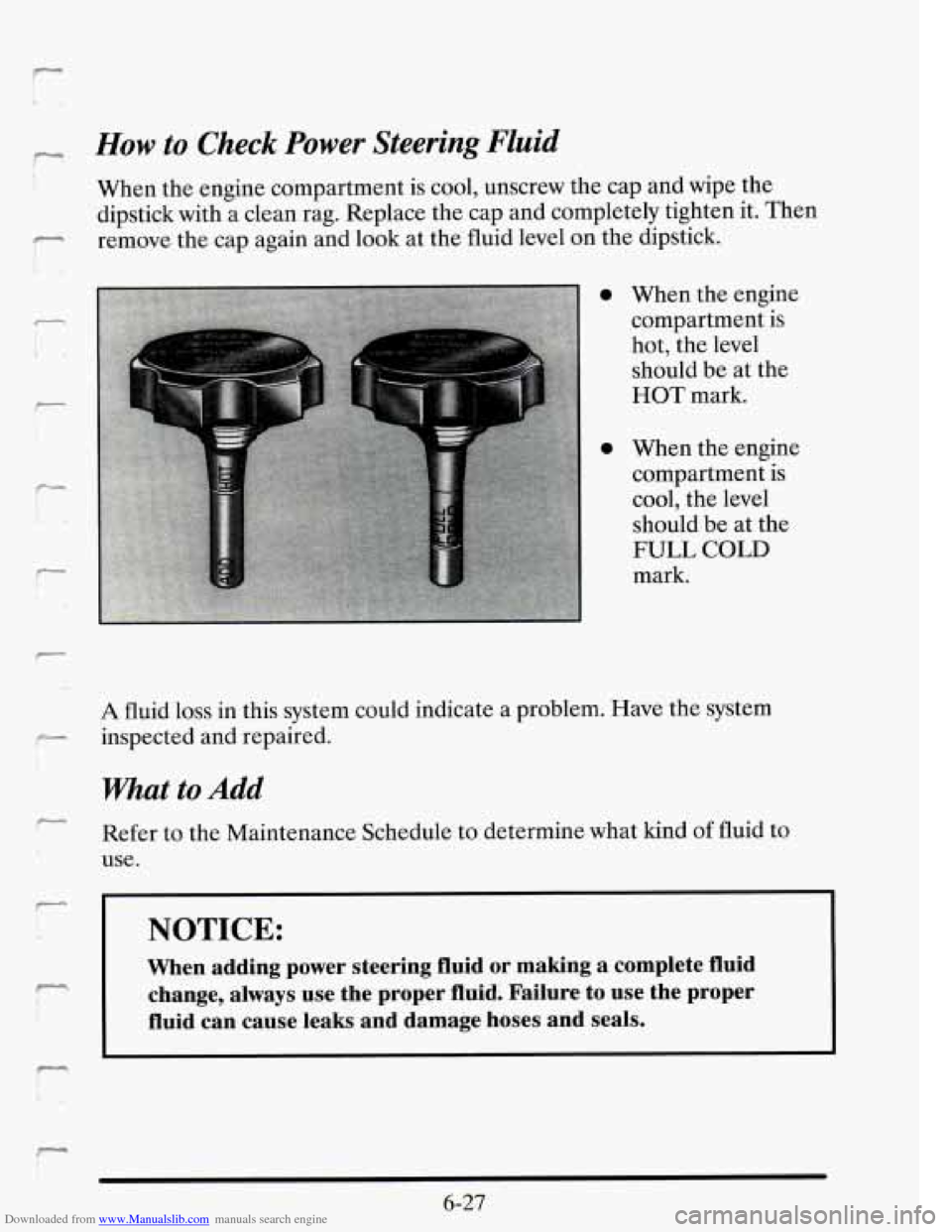
Downloaded from www.Manualslib.com manuals search engine - How to Check Power Steering Fluid
When the engine compartment is cool, unscrew the cap and wipe the
dipstick with a clean rag. Replace the cap and completely tighten it. Then
- remove the cap again and look at the fluid level on the dipstick.
0
0 When the engine compartment is
hot, the level
should be at the
HOT mark.
When the engine compartment is
cool, the level
should be at the
FULL COLD
mark.
A fluid loss in this system could indicate a problem. Have the system
,- inspected and repaired.
What to Add
r Refer to the Maintenance Schedule to determine what kind of fluid to
use.
NOTICE:
When adding power steering fluid or making a complete fluid
change, always use the proper fluid. Failure to use the proper
fluid can cause leaks and damage hoses and seals.
n
6-27
Page 338 of 410
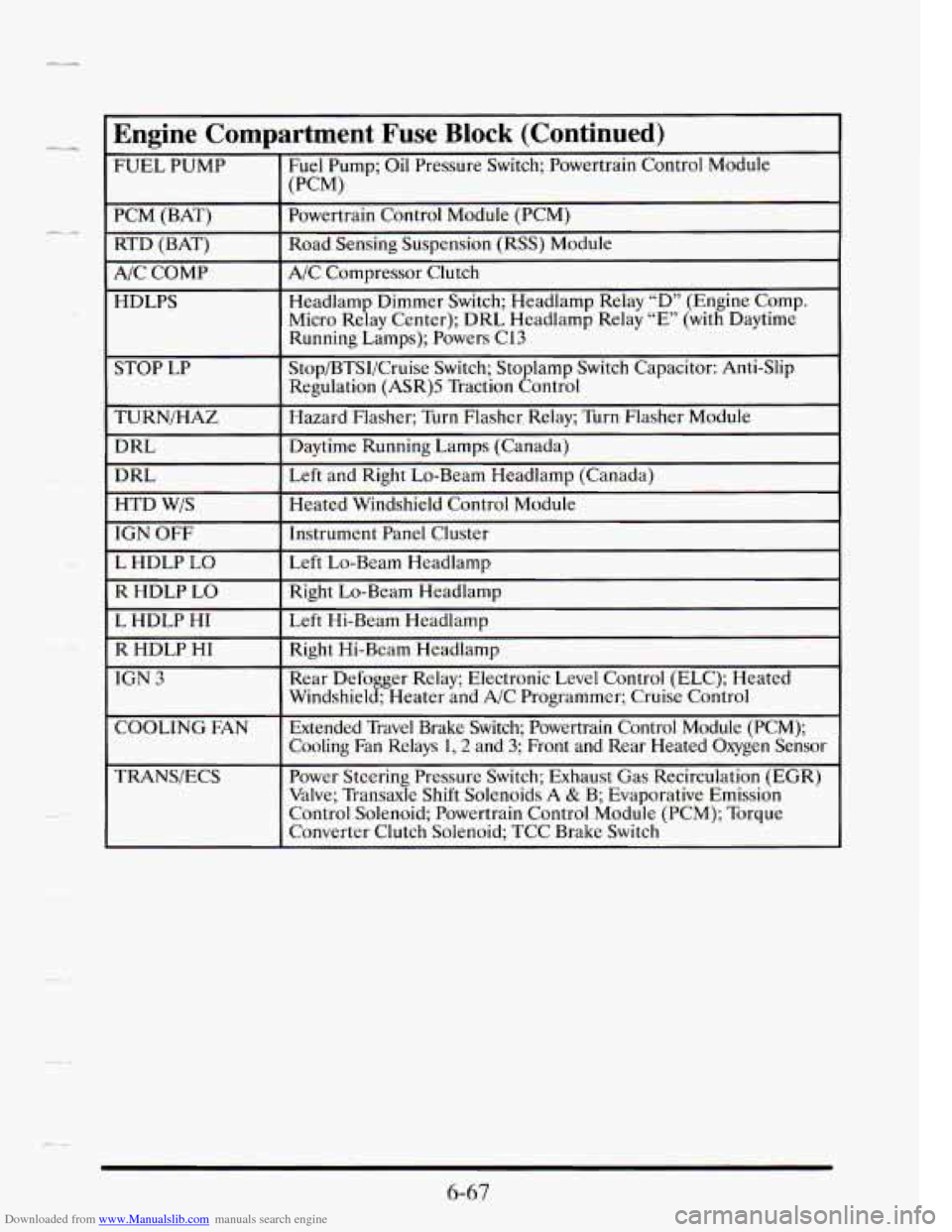
Downloaded from www.Manualslib.com manuals search engine Engine Compartment Fuse Block (Continued)
FUEL PUMP Fuel Pump; Oil
Pressure Switch; Powertrain Control Module
(PW
PCM (BAT)
Headlamp Dimmer Switch; Headlamp Relay “D” (Engine Comp.
HDLPS A/C
Compressor Clutch
A/C COMP Road Sensing
Suspension (RSS) Module
RTD (BAT) Powertrain Control
Module (PCM)
Micro Relay Center); DRL Headlamp Relay
“E” (with Daytime
Running Lamps); Powers C13
STOP LP Stop/BTSI/Cruise
Switch; Stoplamp Switch Capacitor: Anti-Slip
Regulation (ASR)S Traction Control
I
TURN/HAZ I Hazard Flasher; Turn Flasher Relay; Turn Flasher Module
DRL
Rear Defogger Relay; Electronic Level Control (ELC); Heated
IGN 3 Right Hi-Beam Headlamp
R HDLP HI Left Hi-Beam Headlamp
L HDLP
HI Right Lo-Beam Headlamp
R HDLP LO Left Lo-Beam Headlamp
L HDLP
LO
Instrument Panel Cluster IGN OFF
Heated Windshield Control Module
HTD W/S
Left and Right Lo-Beam Headlamp (Canada) DRL
Daytime
Running Lamps (Canada)
Windshield; Heater and
A/C Programmer; Cruise Control
COOLING
FAN Extended Travel Brake Switch; Powertrain Control Module (PCM); \
Cooling
Fan Relays 1,2 and 3; Front and Rear Heated Oxygen Sensor
TRANS/ECS Power
Steering Pressure Switch; Exhaust Gas Recirculation (EGR)
Valve; Transaxle Shift Solenoids
A & B; Evaporative Emission
Control Solenoid; Powertrain Control Module (PCM); Torque
Converter Clutch Solenoid; TCC Brake Switch
6-67
Page 346 of 410
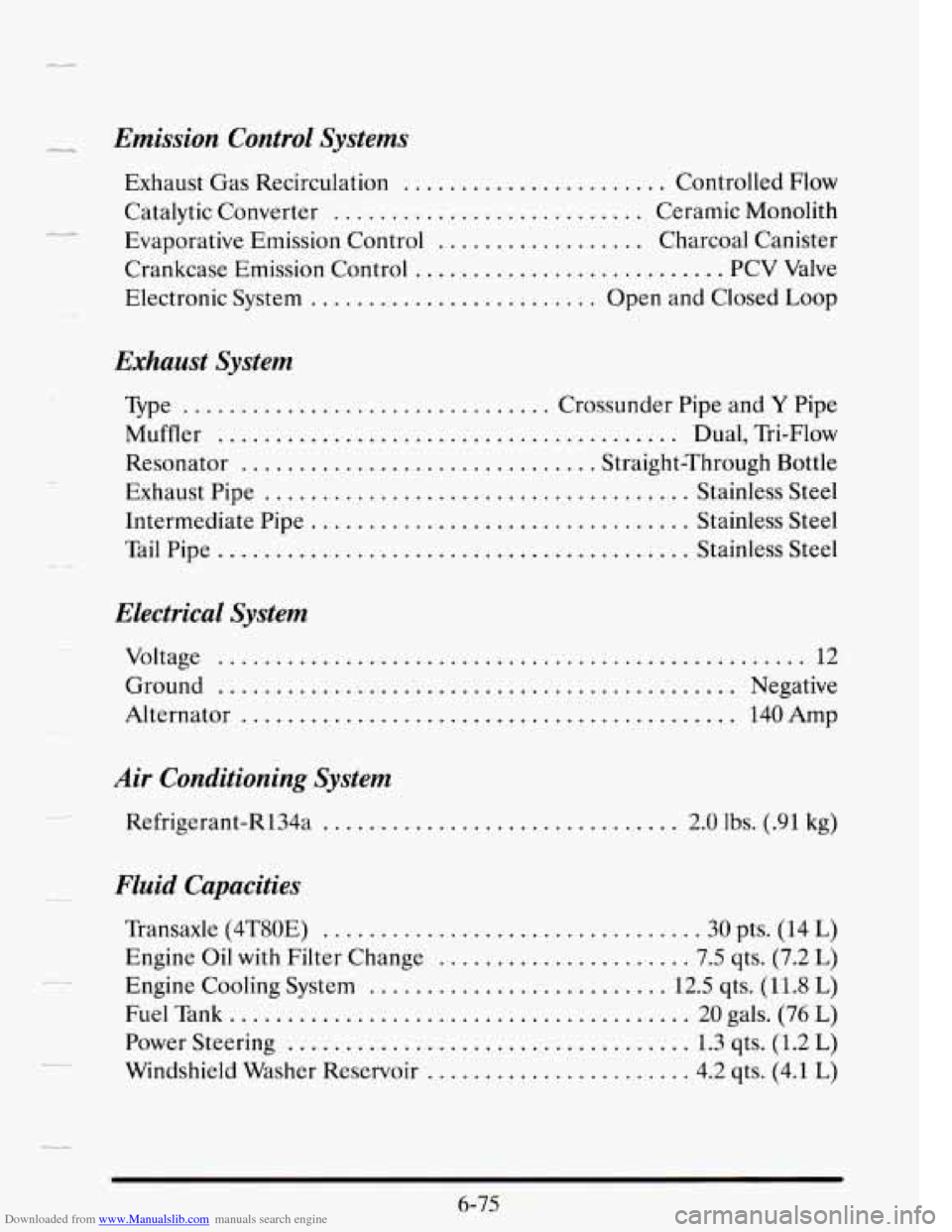
Downloaded from www.Manualslib.com manuals search engine Emission Control Systems
C.._
Exhaust Gas Recirculation ....................... Controlled Flow
Catalytic Converter ........................... Ceramic Monolith
Evaporative Emission Control
.................. Charcoal Canister
Crankcase Emission Control
........................... PCV Valve
Electronic System
......................... Open and Closed Loop
Exhaust System
Type ................................ Crossunder Pipe and Y Pipe
Muffler
........................................ Dual, Tri-Flow
Resonator
............................... Straight-Through Bottle
Exhaust Pipe
..................................... Stainless Steel
Intermediate Pipe
................................. Stainless Steel
Tail Pipe
......................................... Stainless Steel
Electrical System
Voltage ................................................... 12
Ground
.............................................. Negative
Alternator
........................................... 140Amp
Air Conditioning System
Refrigerant-R134a ............................... 2.0 lbs. (.91 kg)
Fluid Capacities
Transaxle (4T80E) ................................ .30 pts. (14 L)
Engine Oil with Filter Change ...................... 7.5 qts. (7.2 L)
Engine Cooling System .......................... 12.5 qts. (1 1.8 L)
Fuel Tank. ....................................... 20 gals. (76 L)
Power Steering ................................... 1.3 qts. (1.2 L)
Windshield Washer Reservoir ....................... 4.2 qts. (4.1 L)
Page 393 of 410
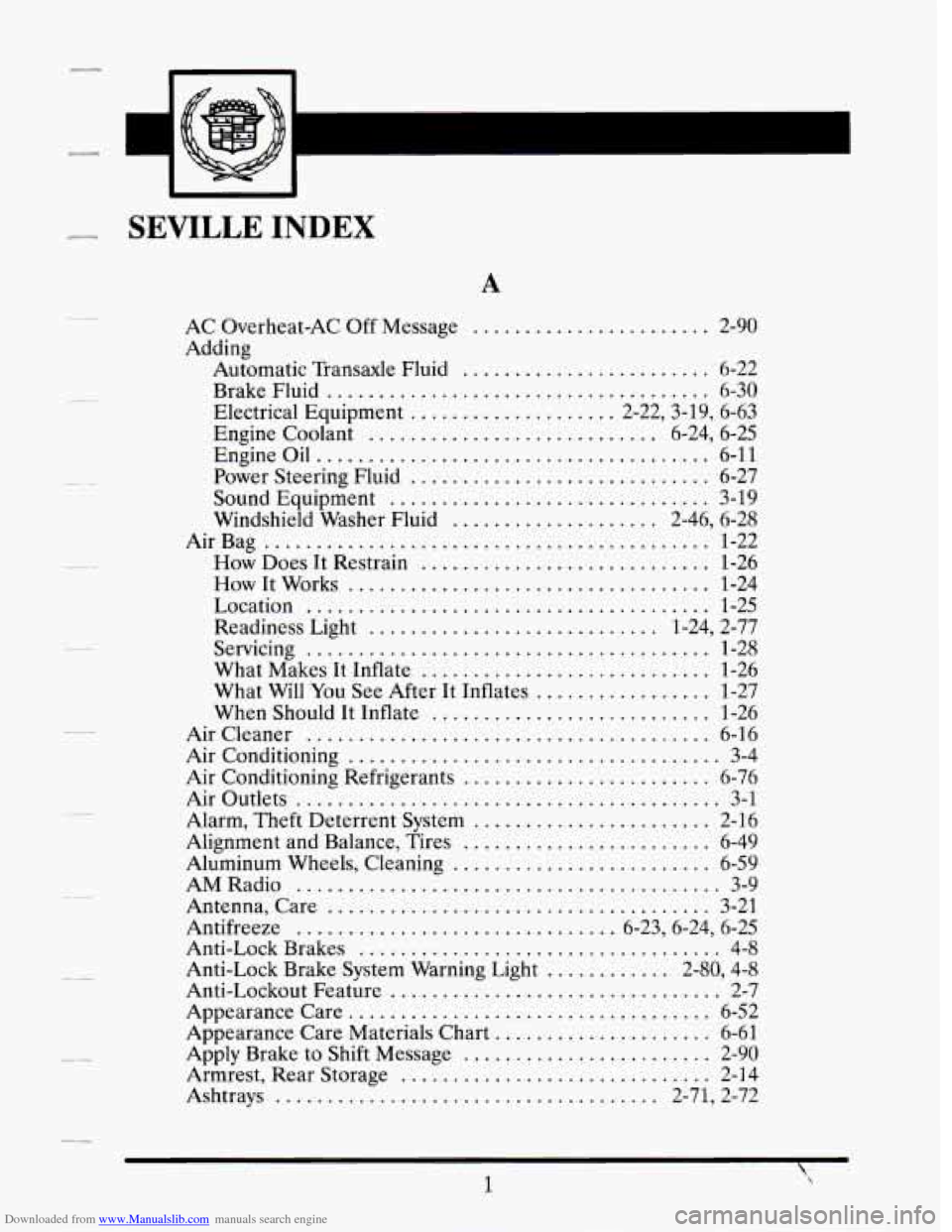
Downloaded from www.Manualslib.com manuals search engine .
.
..
.
.
.
3 .
SEVILLE INDEX
A
AC Overheat-AC Off Message ....................... 2-90
Adding Automatic Transaxle Fluid
........................ 6-22
Brake Fluid
..................................... 6-30
Electrical Equipment
.................... 2.22. 3.19. 6-63
Engine Coolant
............................ 6.24. 6.25
Engine Oil
...................................... 6-11
Power Steering Fluid
............................. 6-27
Sound Equipment
............................... 3-19
Windshield Washer Fluid
.................... 2.46. 6.28
Air Bag
........................................... 1-22
How
Does It Restrain ............................ 1-26
How It Works
................................... 1-24
Location
....................................... 1-25
Readiness Light
............................ 1.24, 2.77
Servicing
....................................... 1-28
What Makes It Inflate
............................ 1-26
What Will
You See After It Inflates ................. 1-27
When Should It Inflate
........................... 1-26
Aircleaner
....................................... 6-16
Air Conditioning .................................... 3-4
Air Conditioning Refrigerants
........................ 6-76
Air Outlets
......................................... 3-1
Alarm. Theft Deterrent System ....................... 2-3.6
Alignment and Balance. Tires
........................ 6-49
Aluminum Wheels. Cleaning
......................... 6-59
AM Radio
......................................... 3-9
Antenna. Care ..................................... 3-21
Antifreeze
............................... 6.23.6.24. 6.25
Anti-Lock Brakes
................................... 4-8
Anti-Lock Brake System Warning Light ............ 2.80. 4.8
Anti-Lockout Feature
................................ 2-7
Appearance Care
................................... 6-52
Appearance Care Materials Chart
..................... 6-61
Apply Brake to Shift Message
........................ 2-90
Armrest. Rear Storage
.............................. 2-14
Ashtrays
..................................... 2.71. 2.72
1
.
Page 395 of 410
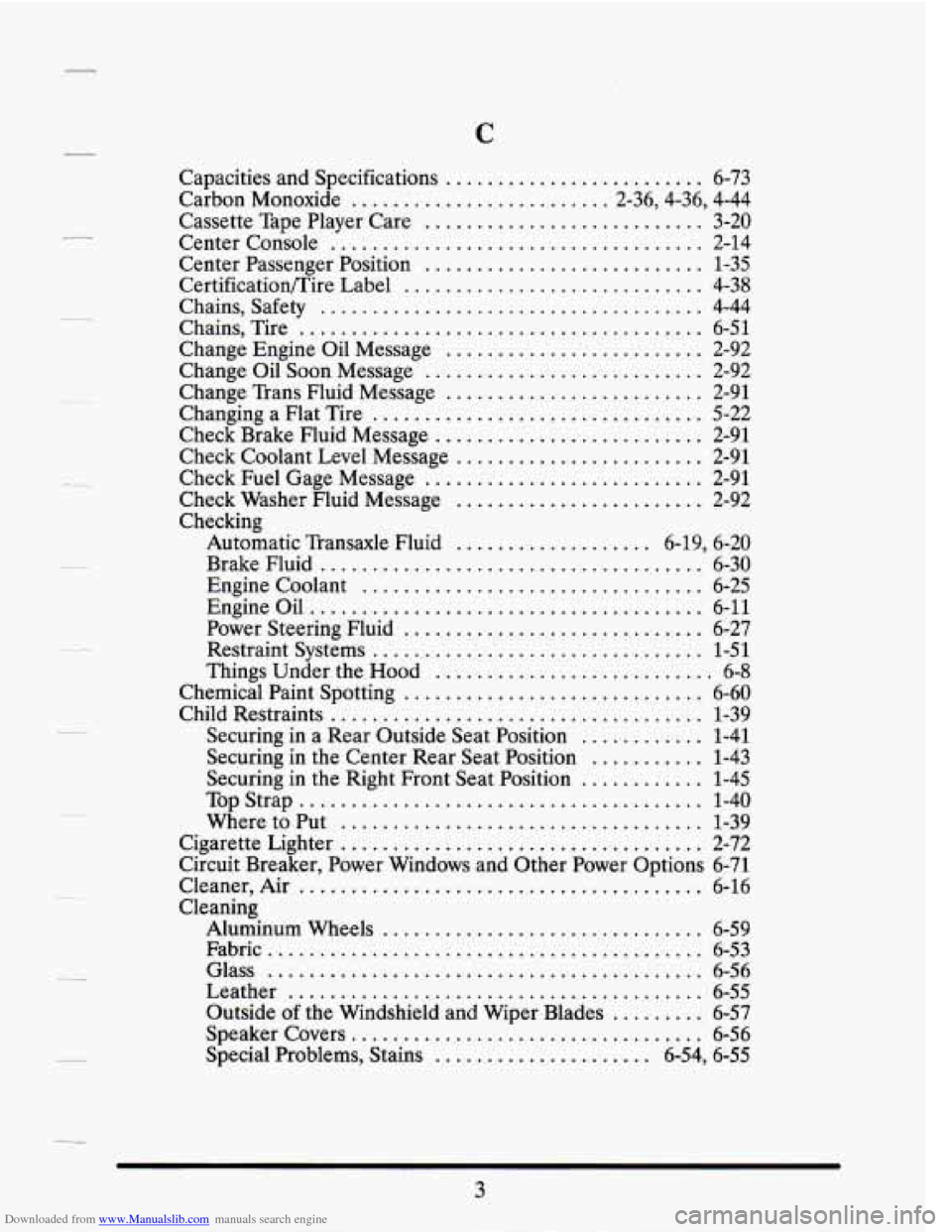
Downloaded from www.Manualslib.com manuals search engine C .
.
.
.
I-
.
.-
..
.
.
Capacities and Specifications ......................... 6-73
Carbon Monoxide ......................... 2.36.4.36, 4.44
Cassette Tape Player Care ........................... 3-20
Center Console .................................... 2-14
Center Passenger Position ........................... 1-35
Certificationnire Label ............................. 4-38
Chains. Safety ..................................... 4-44
Chains. Tire ....................................... 6-51
Change Engine Oil Message ......................... 2-92
Change Oil Soon Message ........................... 2-92
Change Trans Fluid Message ......................... 2-91
Changing a Flat Tire ................................ 5-22
Check Brake Fluid Message .......................... 2-91
Check Coolant Level Message ........................ 2-91
Check Fuel Gage Message ........................... 2-91
Check Washer Fluid Message ........................ 2-92
Checking
Automatic Transaxle Fluid
................... 6.19. 6-20
Brake Fluid ..................................... 6-30
Engine Coolant ................................. 6-25
Engine Oil ...................................... 6-11
Power Steering Fluid ............................. 6-27
Restraint Systems ................................ 1-51
Things Under the Hood ........................... 6-8
Chemical Paint Spotting ............................. 6-60
Child Restraints .................................... 1-39
Securing in a Rear Outside Seat Position ............ 1-41
Securing in the Center Rear Seat Position ........... 1-43
Securing in the Right Front Seat Position ............ 1-45
Top Strap ....................................... 1-40
Where to Put ................................... 1-39
Cigarette Lighter ................................... 2-72
Circuit Breaker. Power Windows and Other Power Options 6-71
Cleaner. Air ....................................... 6-16
Cleaning
Aluminum Wheels
............................... 6-59
Fabric .......................................... 6-53
Glass .......................................... 6-56
Leather ........................................ 6-55
Outside of the Windshield and Wiper Blades ......... 6-57
Speaker Covers .................................. 6-56
Special Problems. Stains ..................... 6-54. 6-55
3